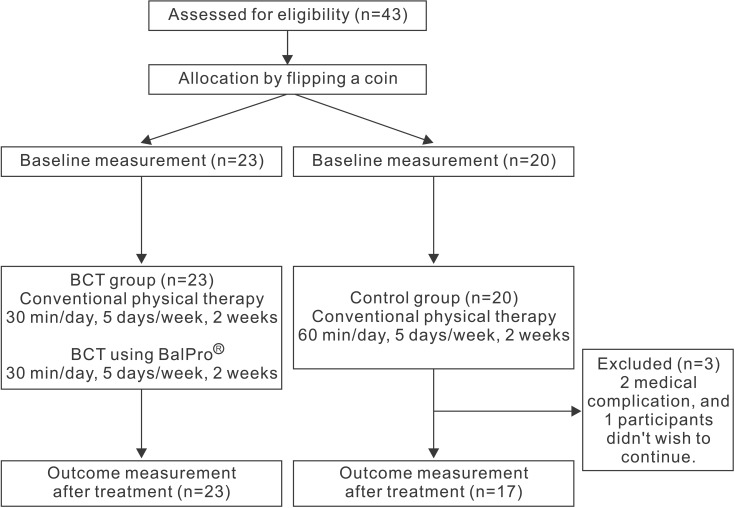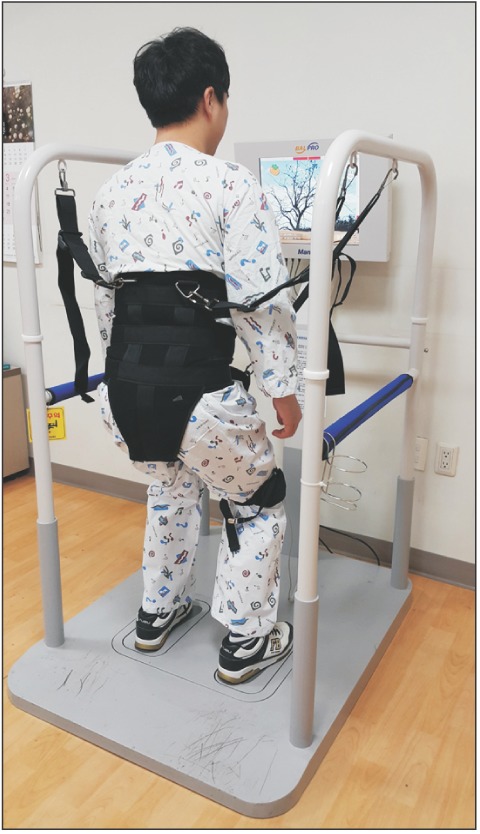Effects of Balance Control Training on Functional Outcomes in Subacute Hemiparetic Stroke Patients
- Affiliations
-
- 1Department of Rehabilitation Medicine, Kyungpook National University College of Medicine, Daegu, Korea. teeed0522@hanmail.net
- 2Department of Rehabilitation Medicine, Kyungpook National University Hospital, Daegu, Korea.
- KMID: 2165627
- DOI: http://doi.org/10.5535/arm.2015.39.6.995
Abstract
OBJECTIVE
To investigate the efficacy of balance control training using a newly developed balance control trainer (BalPro) on the balance and gait of patients with subacute hemiparetic stroke.
METHODS
Forty-three subacute stroke patients were assigned to either a balance control training (BCT) group or a control group. The BCT group (n=23) was trained with BalPro for 30 minutes a day, 5 days a week for 2 weeks, and received one daily session of conventional physical therapy. The control group (n=20) received two sessions of conventional physical therapy every day for 2 weeks. The primary outcome was assessment with the Berg Balance Scale (BBS). Secondary outcomes were Functional Ambulation Category (FAC), the 6-minute walking test (6mWT), Timed Up and Go (TUG), the Korean version of Modified Barthel Index (K-MBI), and the manual muscle test (MMT) of the knee extensor. All outcome measures were evaluated before and after 2 weeks of training in both groups.
RESULTS
There were statistically significant improvements in all parameters except MMT and FAC after 2 weeks of treatment in both groups. After training, the BCT group showed greater improvements in the BBS and the 6mWT than did the control group.
CONCLUSION
Balance control training using BalPro could be a useful treatment for improving balance and gait in subacute hemiparetic stroke patients.
Keyword
Figure
Cited by 3 articles
-
The Relations between Sitting Balance and Functional Recovery according to Characteristics of the Stroke Patients
Da-Sol Kim, Myoung-Hwan Ko, Yu Hui Won, Sung-Hee Park, Jeong-Hwan Seo, Gi-Wook Kim
Brain Neurorehabil. 2020;13(1):. doi: 10.12786/bn.2020.13.e2.Investigating the Dose-Related Effects of Video Game Trunk Control Training in Chronic Stroke Patients With Poor Sitting Balance
Hyun Young Kim, Hyun Im Moon, You Hyeon Chae, Tae Im Yi
Ann Rehabil Med. 2018;42(4):514-520. doi: 10.5535/arm.2018.42.4.514.Effect of Task-Specific Lower Extremity Training on Cognitive and Gait Function in Stroke Patients: A Prospective Randomized Controlled Trial
Sae Hoon Chung, Ji Hyun Kim, Sang Yeol Yong, Young Hee Lee, Jung Mee Park, Sung Hoon Kim, Hi Chan Lee
Ann Rehabil Med. 2019;43(1):1-10. doi: 10.5535/arm.2019.43.1.1.
Reference
-
1. Brandstater ME, de Bruin H, Gowland C, Clark BM. Hemiplegic gait: analysis of temporal variables. Arch Phys Med Rehabil. 1983; 64:583–587. PMID: 6661021.2. Moseley AM, Stark A, Cameron ID, Pollock A. Treadmill training and body weight support for walking after stroke. Cochrane Database Syst Rev. 2005; (4):CD002840. PMID: 16235304.
Article3. Lorish TR, Sandin KJ, Roth EJ, Noll SF. Stroke rehabilitation. 3: Rehabilitation evaluation and management. Arch Phys Med Rehabil. 1994; 75(5 Spec No):S47–S51. PMID: 7514395.4. Patton J, Brown DA, Peshkin M, Santos-Munne JJ, Makhlin A, Lewis E, et al. KineAssist: design and development of a robotic overground gait and balance therapy device. Top Stroke Rehabil. 2008; 15:131–139. PMID: 18430678.
Article5. Mayr A, Kofler M, Quirbach E, Matzak H, Frohlich K, Saltuari L. Prospective, blinded, randomized cross-over study of gait rehabilitation in stroke patients using the Lokomat gait orthosis. Neurorehabil Neural Repair. 2007; 21:307–314. PMID: 17476001.
Article6. Husemann B, Muller F, Krewer C, Heller S, Koenig E. Effects of locomotion training with assistance of a robot-driven gait orthosis in hemiparetic patients after stroke: a randomized controlled pilot study. Stroke. 2007; 38:349–354. PMID: 17204680.7. Shumway-Cook A, Woollacott MH. Motor control: translating research into clinical practice. 3rd ed. Philadelphia: Lippincott Williams & Wilkins;2007. p. 3–83.8. Perry J, Burnfield JM. Gait analysis: normal and pathological function. 2nd ed. Thorofare: Slack Inc.;2010.9. Bobath B. Adult hemiplegia: evaluation and treatment. 3rd ed. London: Butterworth-Heinemann;1990. p. 70–160.10. Lee SH, Byun SD, Kim CH, Go JY, Nam HU, Huh JS, et al. Feasibility and effects of newly developed balance control trainer for mobility and balance in chronic stroke patients: a randomized controlled trial. Ann Rehabil Med. 2012; 36:521–529. PMID: 22977778.
Article11. Bonita R, Beaglehole R. Recovery of motor function after stroke. Stroke. 1988; 19:1497–1500. PMID: 3201508.
Article12. Liston RA, Brouwer BJ. Reliability and validity of measures obtained from stroke patients using the Balance Master. Arch Phys Med Rehabil. 1996; 77:425–430. PMID: 8629916.
Article13. Goldie PA, Bach TM, Evans OM. Force platform measures for evaluating postural control: reliability and validity. Arch Phys Med Rehabil. 1989; 70:510–517. PMID: 2742465.14. Dickstein R, Nissan M, Pillar T, Scheer D. Foot-ground pressure pattern of standing hemiplegic patients: major characteristics and patterns of improvement. Phys Ther. 1984; 64:19–23. PMID: 6691049.15. Verma R, Arya KN, Sharma P, Garg RK. Understanding gait control in post-stroke: implications for management. J Bodyw Mov Ther. 2012; 16:14–21. PMID: 22196422.
Article16. Bohannon RW. Gait performance of hemiparetic stroke patients: selected variables. Arch Phys Med Rehabil. 1987; 68:777–781. PMID: 3675175.17. Nichols DS, Miller L, Colby LA, Pease WS. Sitting balance: its relation to function in individuals with hemiparesis. Arch Phys Med Rehabil. 1996; 77:865–869. PMID: 8822675.
Article18. Fishman MN, Nichols DS, Colby IA, Sachs L. Comparison of functional upper extremity tasks and dynamic standing balance in hemiparesis. Phys Ther. 1996; 76:S79.19. Schmid AA, Van Puymbroeck M, Altenburger PA, Miller KK, Combs SA, Page SJ. Balance is associated with quality of life in chronic stroke. Top Stroke Rehabil. 2013; 20:340–346. PMID: 23893833.
Article20. Winstein CJ. Knowledge of results and motor learning: implications for physical therapy. Phys Ther. 1991; 71:140–149. PMID: 1989009.21. de Haart M, Geurts AC, Dault MC, Nienhuis B, Duysens J. Restoration of weight-shifting capacity in patients with postacute stroke: a rehabilitation cohort study. Arch Phys Med Rehabil. 2005; 86:755–762. PMID: 15827928.
Article22. Richards CL, Malouin F, Wood-Dauphinee S, Williams JI, Bouchard JP, Brunet D. Task-specific physical therapy for optimization of gait recovery in acute stroke patients. Arch Phys Med Rehabil. 1993; 74:612–620. PMID: 8503751.
Article23. Lai CH, Peng CW, Chen YL, Huang CP, Hsiao YL, Chen SC. Effects of interactive video-game based system exercise on the balance of the elderly. Gait Posture. 2013; 37:511–515. PMID: 23177921.
Article24. Morone G, Tramontano M, Iosa M, Shofany J, Iemma A, Musicco M, et al. The efficacy of balance training with video game-based therapy in subacute stroke patients: a randomized controlled trial. Biomed Res Int. 2014; 2014:580861. PMID: 24877116.
Article25. Nichols DS. Balance retraining after stroke using force platform biofeedback. Phys Ther. 1997; 77:553–558. PMID: 9149764.
Article26. Betker AL, Szturm T, Moussavi ZK, Nett C. Video game-based exercises for balance rehabilitation: a single-subject design. Arch Phys Med Rehabil. 2006; 87:1141–1149. PMID: 16876562.
Article27. Winstein CJ, Gardner ER, McNeal DR, Barto PS, Nicholson DE. Standing balance training: effect on balance and locomotion in hemiparetic adults. Arch Phys Med Rehabil. 1989; 70:755–762. PMID: 2802955.28. Geiger RA, Allen JB, O'Keefe J, Hicks RR. Balance and mobility following stroke: effects of physical therapy interventions with and without biofeedback/forceplate training. Phys Ther. 2001; 81:995–1005. PMID: 11276182.
Article29. Hesse S, Bertelt C, Jahnke MT, Schaffrin A, Baake P, Malezic M, et al. Treadmill training with partial body weight support compared with physiotherapy in nonambulatory hemiparetic patients. Stroke. 1995; 26:976–981. PMID: 7762049.
Article30. Barclay-Goddard R, Stevenson T, Poluha W, Moffatt ME, Taback SP. Force platform feedback for standing balance training after stroke. Cochrane Database Syst Rev. 2004; (4):CD004129. PMID: 15495079.
Article31. Lee MY, Wong MK, Tang FT, Cheng PT, Lin PS. Comparison of balance responses and motor patterns during sit-to-stand task with functional mobility in stroke patients. Am J Phys Med Rehabil. 1997; 76:401–410. PMID: 9354495.32. Cheng PT, Liaw MY, Wong MK, Tang FT, Lee MY, Lin PS. The sit-to-stand movement in stroke patients and its correlation with falling. Arch Phys Med Rehabil. 1998; 79:1043–1046. PMID: 9749681.
Article33. Vander Linden DW, Brunt D, McCulloch MU. Variant and invariant characteristics of the sit-to-stand task in healthy elderly adults. Arch Phys Med Rehabil. 1994; 75:653–660. PMID: 8002764.
Article34. Byun SD, Jung TD, Kim CH, Lee YS. Effects of the sliding rehabilitation machine on balance and gait in chronic stroke patients: a controlled clinical trial. Clin Rehabil. 2011; 25:408–415. PMID: 21131336.35. Rasekaba T, Lee AL, Naughton MT, Williams TJ, Holland AE. The six-minute walk test: a useful metric for the cardiopulmonary patient. Intern Med J. 2009; 39:495–501. PMID: 19732197.
Article
- Full Text Links
- Actions
-
Cited
- CITED
-
- Close
- Share
- Similar articles
-
- The Effects of Additional Balance Training in Subacute Hemiplegic Stroke Patients
- The Effect of Dual-Task Training on Balance and Cognition in Patients With Subacute Post-Stroke
- The Efficacy of Core Strengthening on the Trunk Balance in Patients with Subacute Stroke
- Association Between Evoked Potentials and Balance Recovery in Subacute Hemiparetic Stroke Patients
- The Effects of Biofeedback Balance Training Using InteractiveBalance System in Acute Stroke Patients



